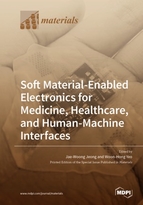Soft Material-Enabled Electronics for Medicine, Healthcare, and Human-Machine Interfaces
A special issue of Materials (ISSN 1996-1944).
Deadline for manuscript submissions: closed (31 October 2019) | Viewed by 82473
Special Issue Editors
Interests: nanomanufacturing; biosensors; bioelectronics; soft robotics; human–machine interfaces
Special Issues, Collections and Topics in MDPI journals
Special Issue Information
Dear Colleagues,
Soft, functional materials enable comfortable, low-profile electronic systems, including sensors, stimulators, and actuators, for applications in medicine, healthcare, and human–machine interfaces. Engineering of materials that provide a very small form factor when integrated with functional components makes extremely flexible and stretchable electronics, which can overcome the current limitations of existing electronics based on rigid, planar materials. In addition, soft electronics-enabled biosystems offer compliant, ergonomic interactions and tissue-conformal lamination with a human body for highly sensitive detection of physiological signals.
This Special Issue focuses on the use of soft, hybrid, functional materials to design and develop unobtrusive, multifunctional wearable and implantable electronics for biomedical applications. Specifically, we seek papers that discuss new soft materials, flexible/stretchable sensors, and soft actuators to advance fundamental knowledge or technology in human health monitoring, disease diagnostics, healthcare, brain–computer interactions, and human–machine interfaces.
We invite full papers, communications, and reviews that cover one or several of the listed keywords below.
Prof. Dr. W. Hong Yeo
Prof. Dr. Jae-Woong Jeong
Guest Editors
Manuscript Submission Information
Manuscripts should be submitted online at www.mdpi.com by registering and logging in to this website. Once you are registered, click here to go to the submission form. Manuscripts can be submitted until the deadline. All submissions that pass pre-check are peer-reviewed. Accepted papers will be published continuously in the journal (as soon as accepted) and will be listed together on the special issue website. Research articles, review articles as well as short communications are invited. For planned papers, a title and short abstract (about 100 words) can be sent to the Editorial Office for announcement on this website.
Submitted manuscripts should not have been published previously, nor be under consideration for publication elsewhere (except conference proceedings papers). All manuscripts are thoroughly refereed through a single-blind peer-review process. A guide for authors and other relevant information for submission of manuscripts is available on the Instructions for Authors page. Materials is an international peer-reviewed open access semimonthly journal published by MDPI.
Please visit the Instructions for Authors page before submitting a manuscript. The Article Processing Charge (APC) for publication in this open access journal is 2600 CHF (Swiss Francs). Submitted papers should be well formatted and use good English. Authors may use MDPI's English editing service prior to publication or during author revisions.
Keywords
- soft material
- wearable electronics
- implantable electronics
- biosensing
- diagnostics
- health monitoring
- human–machine interface








